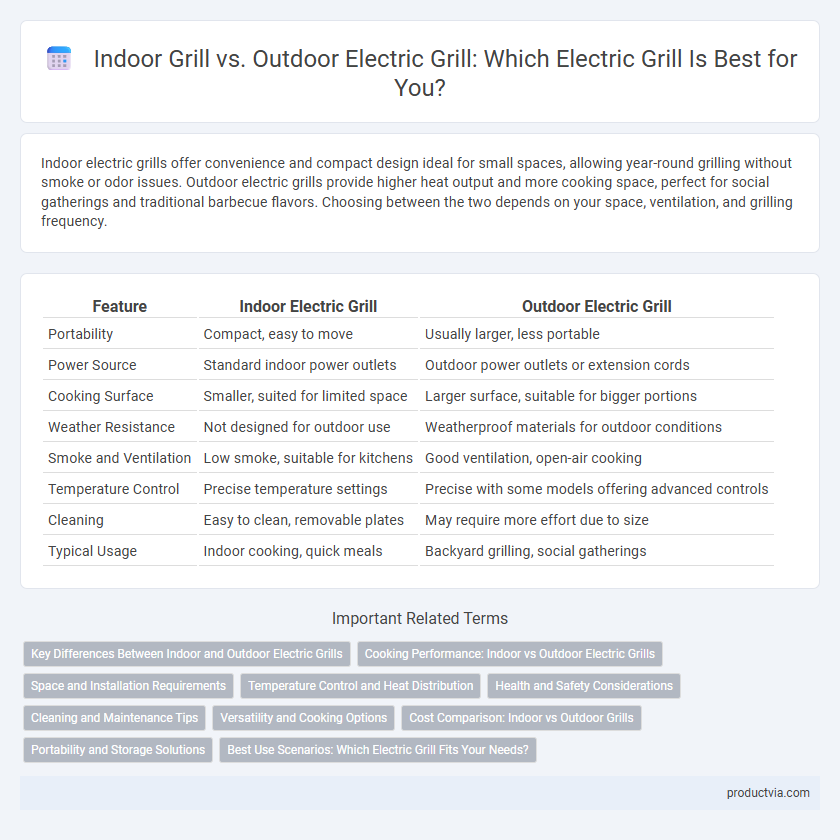Indoor electric grills offer convenience and compact design ideal for small spaces, allowing year-round grilling without smoke or odor issues. Outdoor electric grills provide higher heat output and more cooking space, perfect for social gatherings and traditional barbecue flavors. Choosing between the two depends on your space, ventilation, and grilling frequency.
Table of Comparison
| Feature | Indoor Electric Grill | Outdoor Electric Grill |
|---|---|---|
| Portability | Compact, easy to move | Usually larger, less portable |
| Power Source | Standard indoor power outlets | Outdoor power outlets or extension cords |
| Cooking Surface | Smaller, suited for limited space | Larger surface, suitable for bigger portions |
| Weather Resistance | Not designed for outdoor use | Weatherproof materials for outdoor conditions |
| Smoke and Ventilation | Low smoke, suitable for kitchens | Good ventilation, open-air cooking |
| Temperature Control | Precise temperature settings | Precise with some models offering advanced controls |
| Cleaning | Easy to clean, removable plates | May require more effort due to size |
| Typical Usage | Indoor cooking, quick meals | Backyard grilling, social gatherings |
Key Differences Between Indoor and Outdoor Electric Grills
Indoor electric grills are compact, designed for countertop use, and equipped with temperature controls ideal for grilling burgers, vegetables, and sandwiches in confined kitchen spaces. Outdoor electric grills offer larger cooking surfaces, enhanced ventilation systems, and are weather-resistant, making them suitable for backyard grilling with friends and family. Key differences include size, portability, cooking power, and suitability for use environments, impacting heat distribution and smoke management.
Cooking Performance: Indoor vs Outdoor Electric Grills
Indoor electric grills provide consistent heat control and faster preheating times, ideal for cooking smaller portions with even temperature distribution. Outdoor electric grills often deliver higher power output and larger cooking surfaces, facilitating better searing and grilling of bulkier foods with enhanced smoke flavor. Choosing between indoor and outdoor electric grills depends on the desired cooking intensity, capacity, and flavor profile.
Space and Installation Requirements
Indoor electric grills are compact and designed for limited spaces, requiring minimal installation, often just a standard electrical outlet. Outdoor electric grills typically require more space and may need a dedicated power source or outlet with weatherproofing considerations. Both options offer easy setup, but indoor grills prioritize portability and convenience, while outdoor models emphasize durability and larger cooking areas.
Temperature Control and Heat Distribution
Indoor electric grills offer precise temperature control through digital thermostats, ensuring consistent heat for cooking delicate foods. Outdoor electric grills feature broader heat distribution with powerful heating elements designed to handle larger cooking surfaces and higher temperature ranges. Both types prioritize even heat allocation, but indoor models excel in maintaining stable, moderate temperatures while outdoor grills accommodate variable heat for diverse grilling techniques.
Health and Safety Considerations
Indoor electric grills offer controlled temperature settings and smoke extraction features that reduce carcinogen exposure and minimize fire hazards, promoting safer cooking environments. Outdoor electric grills provide better ventilation, lowering the risk of smoke inhalation and accumulation of harmful gases, which is crucial for health during grilling. Choosing a grill with automatic shut-off and cool-touch surfaces enhances safety regardless of indoor or outdoor use.
Cleaning and Maintenance Tips
Indoor electric grills typically feature removable plates with non-stick coatings, making cleaning faster and less labor-intensive, while outdoor electric grills often have larger surfaces requiring brushes and specialized tools for effective maintenance. Regularly wiping down drip trays and heating elements prevents residue buildup and extends the lifespan of both grill types. Proper cleaning protocols, such as avoiding abrasive materials on non-stick surfaces and ensuring outdoor grills are covered when not in use, minimize rust and preserve performance.
Versatility and Cooking Options
Indoor electric grills offer exceptional versatility for year-round cooking with features like adjustable temperature controls and non-stick surfaces, allowing for grilling, searing, and even baking indoors. Outdoor electric grills provide the advantage of larger cooking surfaces and enhanced heat output, making them ideal for grilling multiple food items simultaneously while delivering authentic outdoor flavors. Both types support diverse cooking options, but indoor models excel in convenience and space-saving, whereas outdoor grills emphasize capacity and traditional grilling experiences.
Cost Comparison: Indoor vs Outdoor Grills
Indoor electric grills generally cost less than outdoor electric grills due to compact design and simpler ventilation requirements. Outdoor models often incorporate weather-resistant materials and higher wattage for larger cooking surfaces, increasing overall price. Budget considerations should factor in long-term energy consumption, as indoor grills typically use less power given their smaller size.
Portability and Storage Solutions
Indoor electric grills are designed for compact spaces, featuring lightweight builds and foldable components that enhance portability and ease of storage in kitchen cabinets or small apartments. Outdoor electric grills often prioritize durability and size for enhanced cooking capacity but may include wheels and detachable parts to improve portability and simplify storage in garages or patios. Selecting between indoor and outdoor electric grills depends on available space and transportation needs, with indoor models offering more convenient storage solutions for frequent moves or limited living areas.
Best Use Scenarios: Which Electric Grill Fits Your Needs?
Indoor electric grills are ideal for year-round cooking in small spaces, offering convenience, easy temperature control, and minimal smoke production, making them perfect for apartments or kitchens without outdoor access. Outdoor electric grills excel in providing a traditional grilling experience with higher heat output, suitable for backyard gatherings, tailgating, or when open-air ventilation is preferred. Choosing between indoor and outdoor electric grills depends on factors like space availability, desired cooking environment, and the type of meals you plan to prepare.
Indoor grill vs Outdoor electric grill for electric grill Infographic

 productvia.com
productvia.com